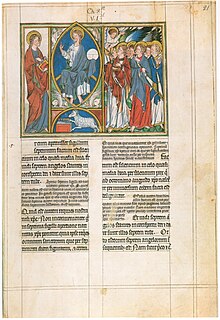Berengaudus

Berengaudus (* probably in the 9th century) was a Carolingian Benedictine in the monastery of Ferrières-en-Gâtinais , Loiret department . He is therefore sometimes also called Berengaudus Ferrariensis and lived in Ferrières before 865 at the time of Abbot Lupus . Berengaudus is known for his text Expositio super septem visiones libri Apocalypsis , a commentary on the Book of Revelation ( Apocalypse ). The name of the author is encoded in it, one of the oldest manuscripts from the 12th century was found in Angers . Due to the interpretation of the text, however, the origin can be convincingly placed in the 9th century, even if copies are only preserved from the period afterwards.
Over 50 copies of the commentary, mainly from the 12th century, were found in French monasteries around Paris and Troyes , for example , but also in England (from Peterborough or Cambridge). The Lambeth Apocalypse from the 11th century also brings excerpts from this commentary. The work was therefore more widespread and there are further indications that it was mainly known and famous in the 12th century. Sometimes the reason given for this fame at the time is the incorrect assignment of the work to Ambrosius of Milan , to whom Erasmus of Rotterdam also awarded the text. Copies of the commentary can still be found in the 14th century, for example in the Book of the Apocalypse illustrated by the master of the Berry Apocalypse from the property of Jean de Valois, Duke of Berry or in a copy of the work from Bavarian from the same century Monasteries. Only when the question of the author was finally clarified by the Parisian Maurinian Fathers in the 18th century, however, Berengaudus clearly names the author.
Compared to other commentators of the Apocalypse, Berengaudus has a different, own interpretation. The four horsemen of the apocalyptic are not incarnations of a calamity for him, but are interpreted by him these riders on the white, the red, the black and the yellow horse as Christ himself, the Bringer of a New World. Optimism and utopian hope in the face of the Last Judgment can still be felt before an eschatological mood begins in the 12th century to see the near judgment as a catastrophe and a warning for people. Berengaudus still sees the Apocalypse as the beginning of a new world, an interpretation that can be found again in the vision of the Ghent Altarpiece in the late Middle Ages in Flanders , which like the unique pictorial language of the Berengaudus text shows a "visionary" interpretation and that also seems to repeat ideas created by Berengaudus in the late Middle Ages.
The commentary is the only remaining text from Berengaudus.
literature
- Berengaudus: Expositio super septem visiones libri Apocalypsis . In: Jacques-Paul Migne, Patrologia. Latina 17, Paris 1864; P. 843ff. (Ad Opera S. Ambrosii Appendix)
- N. Schneider: Jan van Eyck - The Ghent Altarpiece. Proposals for Reforming the Church . Frankfurt 1986
- D. Visser: Apocalypse As Utopian Expectation (800-1500): The Apocalypse commentary of Berengaudus of Ferrières and the Relationship Between Exegesis, Liturgy and Iconography in the History of Christian Thought . Leiden 1996;
- A. Dittrich: The enigmatic Berengaudus . In: Mater Ecclesiae. Würzburg 2009, pp. 90-129.
- W. Müller, H. Lengenfelder (ed.): Block books of the university library in Munich. Historical introduction and catalog descriptions with directory. Munich 2004
- Achim Dittrich: Berengaudus. In: Biographisch-Bibliographisches Kirchenlexikon (BBKL). Volume 31, Bautz, Nordhausen 2010, ISBN 978-3-88309-544-8 , Sp. 90-92.
Web links
- Latin text of the commentary by Berengaudus , at Documenta Catholica Omnia
| personal data | |
|---|---|
| SURNAME | Berengaudus |
| ALTERNATIVE NAMES | Berengaudus Ferrariensis |
| BRIEF DESCRIPTION | Benedictine and author of a commentary on the Apocalypses |
| DATE OF BIRTH | 8th century or 9th century |
| DATE OF DEATH | 9th century or 10th century |